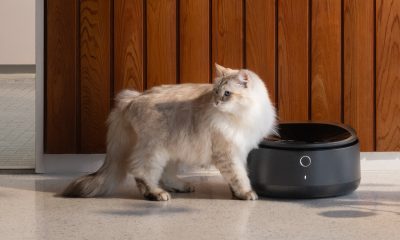Technology
Tesla rival Byton wants you to binge media in the car

In Binged, Mashable breaks down why we binge-watch, how we binge-watch, and what it does to us. Because binge-watching is the new normal.
The screen-filled electric car company Byton knows you can’t put down that Netflix series. Or that podcast, or even that Twitter thread.
The Chinese EV company designed its upcoming M-Byte SUV knowing the car is another place to consume shows, films, music, games, podcasts, and social media GIFs, streaming videos, and more.
This isn’t just about taking on Tesla’s battery, range, and price (the base M-Byte will start at $45,000), but building out a unique user experience inside the car. Already 50,000 reservations have come in for the car slated to arrive in China by the end of the year. Americans can expect to see the new EV brand by the end of 2020.
Beyond the 325-mile range and 95 kWh battery, it’s hard to avoid the screens. There’s the 8-inch touchscreen on the steering wheel, another between the driver and passenger seat, optional screens on the headrests for the backseat, and the massive 48-inch end-to-end gesture-controlled and Alexa-enabled (Baidu in China) curved dashboard screen.
Byton is well aware its screens dominate the conversation. But the company is focusing more on the user experience with its infotainment interface and mobile app. CEO Daniel Kirchert said at its U.S. headquarters in Santa Clara, California, this week it’s what the big screen can do that “will distinguish us from over EV makers out there.” It’s not just a fancy screen, he says. Instead, “it will create a different experience.”
As Toyota finally embraces Android Auto, Byton is going in the other direction. Kirchert envisions Byton riders treating their car as their phone. “You won’t be even tempted to take out your device,” he said. Instead a tailor-made experience for navigation, reading texts, emails, or getting restaurant information will come through the car.
It’s with this mindset that Byton is focusing on the next generation of car buyers. They’re gearing up for a mainly ride-hailing and autonomous future. It’s not even that far off — already passengers using ride-hailing apps are video streaming the Neflix-like service HOOQ in Grab cars in southeast Asia, playing ad-filled trivia games, and buying concert tickets like Cargo’s partnership with SeatGeek in Uber rides. The passenger seat is becoming an experience.
IBM announced a partnership this week with Harley-Davidson’s first electric motorcycle to provide AI, cloud, and Internet of Things connectivity to the motorcycle maker. It initially comes off as a strange pairing, but IBM shared this stat: in 2015, 35 percent of cars were internet-enabled, but by 2020 that’s supposed to be over 90 percent. A connected car will soon be the norm. Car companies are blending into tech companies. Just look at Tesla.
Byton’s M-Byte will be capable of Level 3 autonomy, which is similar to Tesla’s semi-autonomous Autopilot feature. That means the driver still needs to be paying full attention to the road while the car self-navigates and turns, but passengers can plug in and connect, their attention far from the road. Kids in the backseat can keep watching their favorite YouTube videos.
It’s Byton’s next car, the K-Byte sedan, that’s supposed to have higher autonomy. When this truly self-driving car arrives and is allowed to operate in that mode, those screens will transform a ride into a true entertainment space — even for the driver.
The car as the ultimate binging space makes even more sense in an electric vehicle. Fast-charging still takes 30 minutes to reach an 80 percent charge on the Byton. For on-the-go charging, drivers are a captive audience. Instead of twiddling their thumbs at a public charging station while on a road trip, drivers can entertain themselves. Gas station TV has nothing on catching up on the latest episode.
Byton’s bet on our binging habits are in line with other car makers desperately trying to catch up with what people expect out of a car ride. Audi collaborated with Disney to show how car-based VR can entertain passengers. Honda is building out a backseat entertainment platform with games and shopping made for the car.
With the battery underneath the Byton and most of the controls for music, temperature, and more on the screen, the car is full of legroom. Byton’s front seats rotate 12 degrees for a more comfortable lounging environment. The back seats can recline. These little things make it easy to confuse the car for the couch.
Your binge doesn’t stop just because you’re in the car.

-

 Business7 days ago
Business7 days agoTesla’s new growth plan is centered around mysterious cheaper models
-

 Business6 days ago
Business6 days agoXaira, an AI drug discovery startup, launches with a massive $1B, says it’s ‘ready’ to start developing drugs
-

 Business6 days ago
Business6 days agoUK probes Amazon and Microsoft over AI partnerships with Mistral, Anthropic, and Inflection
-

 Entertainment4 days ago
Entertainment4 days agoSummer Movie Preview: From ‘Alien’ and ‘Furiosa’ to ‘Deadpool and Wolverine’
-

 Business5 days ago
Business5 days agoPetlibro’s new smart refrigerated wet food feeder is what your cat deserves
-

 Business4 days ago
Business4 days agoHow Rubrik’s IPO paid off big for Greylock VC Asheem Chandna
-

 Entertainment3 days ago
Entertainment3 days agoWhat’s on the far side of the moon? Not darkness.
-

 Business4 days ago
Business4 days agoThoma Bravo to take UK cybersecurity company Darktrace private in $5B deal





















